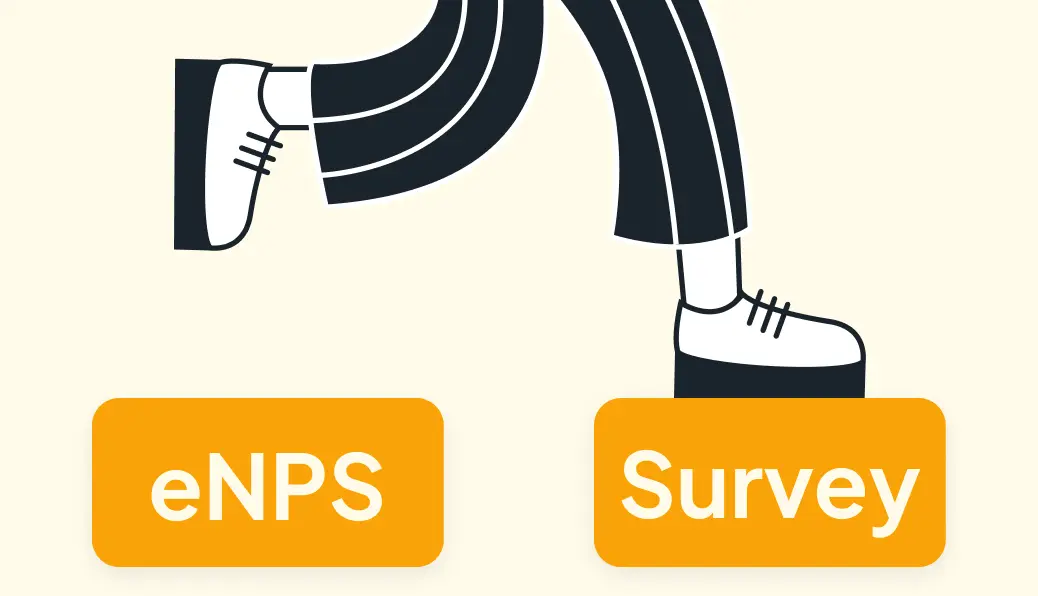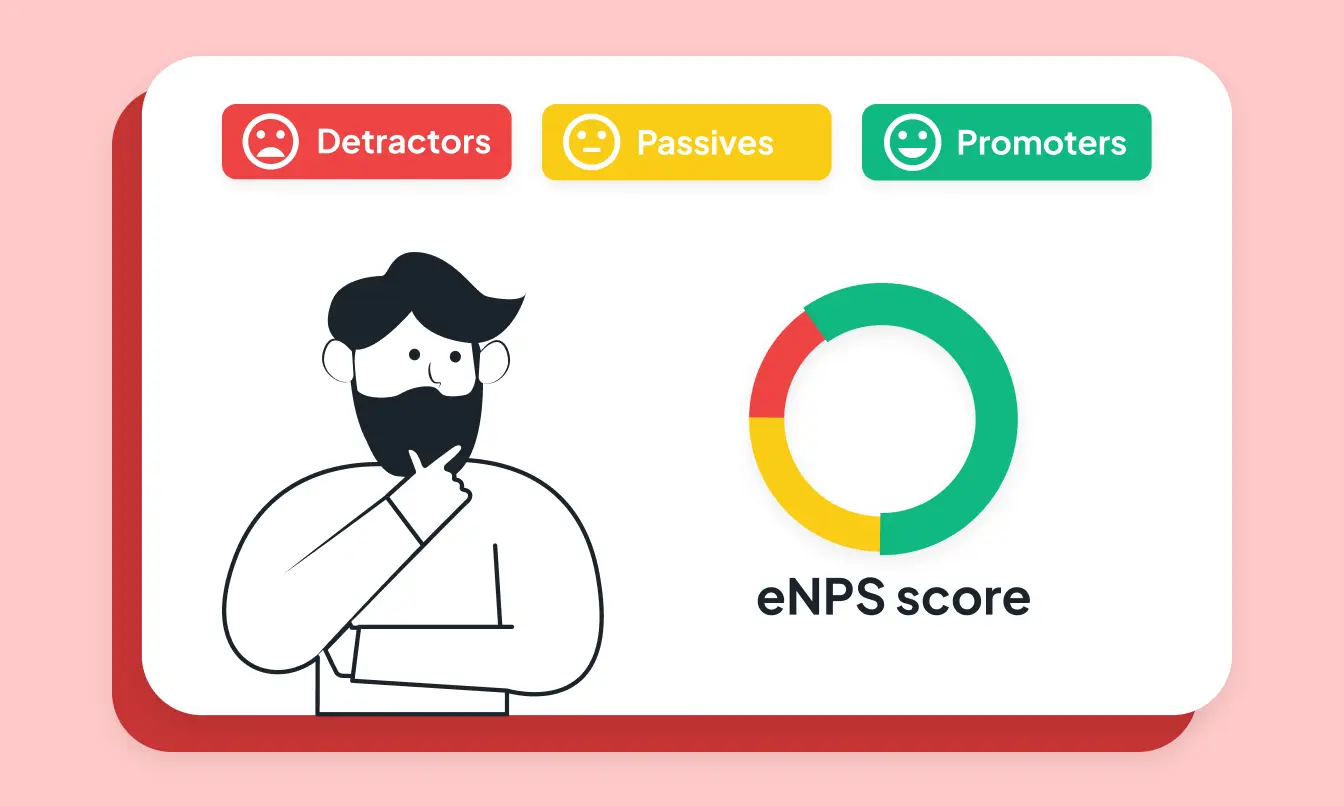
How To Conduct an eNPS Survey: A Step-By-Step Guide


- How To Conduct an eNPS Survey?
- The Importance Of eNPS
- Conclusion
Conducting an eNPS survey is a powerful skill in management, HR departments, and team leadership. Companies gather comprehensive insights into trends and patterns by conducting an eNPS survey.
However, these surveys must be done effectively to do more good and no harm.
eNPS surveys are short but powerful, providing an organization with an assessment of its health and company culture.
In this article, we will discuss how you should conduct an eNPS survey, guiding you through each step and its management.
If you are considering running an eNPS survey, you must know all the details concerning this measuring system.
Proceed with this content to benefit from the guide and improve your survey skills.
If you want to dive even deeper into eNPS surveys, we suggest you read “What Is eNPS?” before proceeding with this article for a more practical experience.
Our Employee Survey Systems allow you to have specifically designed eNPS surveys to serve your company’s needs.
How To Conduct an eNPS Survey?

As with any other organizational tool, eNPS has several regulations and concerns to notice.
We will guide you through this comprehensive process and discuss how each step should be managed for the best possible outcomes.
🧐 Step 1: Acknowledge Your Purpose.
Before conducting an eNPS survey, it is essential for you to define the goals of this survey objectively.
There are some usual criteria for conducting an eNPS survey:
- To check the employee experience annually/quarterly.
- An HR Analysis
- A recent challenging event or change in the work environment
- Other variables affecting the employee sentiment
You should always have a goal in mind before conducting an employee survey, even a small purpose such as an employee insurance review survey.
Not only won't a purposeless eNPS survey help you fix any problems, it will also confuse and frustrate your employees.
It is best that you clarify your goals to achieve the optimum efficacy this survey offers.
⏰ Step 2: Choose The Right Time.
Timing is crucial when conducting an eNPS survey. Many factors impact employee sentiment, including recent challenging events, an administration overhaul, salary changes, etc.
There are two main time-related eNPS concerns to notice:
1. When To Conduct an eNPS Survey:
eNPS surveys should be conducted during calm office time for the best quality responses. You can also send out the questionnaires for your staff to complete in their leisure time.
Avoid conducting surveys during busy office hours. Stressful and emotional times may also affect the response rate and feedback quality.
2. How Long Does an eNPS Survey Take?

Another issue concerning timing is the length of your questionnaires. Even though there are no strict rules on how long your survey should take, we suggest you approach it with a more formal attitude.
We recommend a 30-minute survey for an annual eNPS, a 10-minute survey for a quarterly eNPS, and -at maximum- a 5-minute survey for a monthly eNPS.
✅ Step 3: Choose The Right Questions.
This may sound confusing as it is known for eNPS to have only one key question: “On a scale of 0 to 10, how likely are you to recommend your company as a workplace to others?”
However, this single question only demonstrates the overall employee sentiment at the moment. If you intend to run a successful eNPS survey with insightful outcomes, you should craft it into an exclusively designed questionnaire.
Your questions have three primary categories of choice:
- Open-ended: Use questions such as “What is your primary reason for your given score?” or “What do you value the most in our organization?” Open-ended questions let you see your employees' minds and view your organization from their perspective.
- Yes/No: These questions are both simple and quantifiable. They help you measure how most employees think about a specific subject. You can ask, “Has your management been helpful during challenges?” or “Do you see yourself working here in 5 years?”
- Digital Scale: Similar to the central eNPS question, you ask an employee to rate a matter from a scale of 0 to 10. Apply questions such as “How do you rate the provided resources in your organization?” or “On a scale of 0 to 10, how is your company’s performance compared to what you expected?”
If you need to know more about suitable questions for your eNPS survey and identify your organization’s best areas and potential problems, we suggest you look at our comprehensive guide on “Types of Questions in an eNPS Survey”.
🧠 Step 4: Distribute The Survey.
Conducting an eNPS survey needs a convenient and secure platform. There are several aspects to choosing an eNPS survey platform and putting it into use:
1. Company Size
Larger companies are better to be classified into different departments or teams. This allows you to have a more thorough yet specific survey and responses.
Smaller companies, however, can distribute their surveys collectively.
2. Platform Method
Digital surveys or employee survey systems are excellent approaches to an anonymous and well-handled eNPS survey. Whether or not your company has an existing communication route, you can deeply benefit from a digital eNPS to assess your status.
However, a company with fewer resources can still conduct eNPS surveys via paper or cheaper technology software.
3. Keep Up Morale
You must ensure your employees that the answers are anonymous to encourage honest opinions.
Your employees won’t feel comfortable if they don’t have a sense of job security.
It would help if you communicated with your staff about the survey’s targets and purposes to achieve their full participation.
📞Contact us to guide you through your best eNPS survey choice.
📉 Step 5: Analyze The Data.

Once you have collected the responses, you should analyze the data for trends and patterns in your organization.
Respondent employees are divided into three categories based on their answer to the central question: “On a scale of 0 to 10, how likely are you to recommend your company as a workplace to your family and friends?”
The groups are Promoters (9 or 10), Passives (7 or 8), and Detractors (0-6).
Calculate your eNPS score by subtracting the percentage of detractors from the one of the promoters. Your score is a non-percentage number between -100 and +100.
Evidently, a higher positive number shows more promoters and a positive workforce. Nevertheless, that is not always the case.
Each organization’s situation varies from others’, and the eNPS score only shows an overall estimate of your organization’s status.
However, you should carefully interpret your score since it is not the sole determinant of your company’s well-being.
Read our article “What is a good eNPS score?” to learn more about the dos and don’ts of eNPS score calculation.
💪🏼 Step 6: Take Action.
This is the last and perhaps the most crucial step in conducting an eNPS survey.
After analyzing your staff’s responses, you should start planning different strategies to address their concerns and issues.
A straightforward strategy is to improve your strong suits, as the promoters outlined. You should also go the extra mile and plan for the detractors’ concerns if you want to foster a positive company culture.
Communicate the results and your potential solutions with your employees. Ask your staff about their sentiment on your solutions.
Monitor your progress and changes over time by regularly conducting eNPS surveys. Make suitable adjustments for your organization as you proceed.
Note that these are a simplification of complex solutions; you should find the best details for your organization’s needs.
The Importance Of eNPS
Employee experience defines an organization’s work culture. Positive work cultures tend to create happier and more engaged employees who are likely to stay with their company for a long time.
It is no surprise that a company with high employee engagement rates is more profitable and productive than its competing organizations.
eNPS surveys provide a simple yet effective tool to measure the employee experience.
Employee satisfaction and loyalty are the two main variables in an eNPS survey. However, it is an adjustable survey if your company also requires other data.
eNPS Surveys also help you discover your company's underlying issues and employee concerns before they escalate into a challenge.
Organizations are able to track their employees’ changes and concerns through regular eNPS surveys.
Conclusion
Conducting an eNPS survey is a solid and robust method for organizations that look for employee satisfaction and loyalty measurement. However, it is vital that these surveys are conducted with caution and precision.
Low-quality surveys, failure to act on the responses, and the feeling of job insecurity will result in ineffective feedback and poor communication.
Following the step-by-step process outlined in this guide, you can gather meaningful employee feedback and make insightful decisions to enhance the employee experience.
Regular eNPS surveys help organizations track their performance and trends over time. Employee sentiment, engagement, and work environment changes will be evident if you properly conduct the eNPS surveys.
By submitting this form, I confirm that I have read the privacy policy and that I consent to the processing of my personal data by agyleOS for the purposes stated. In the event of consent, I can revoke my consent at any time. Furthermore, by submitting the form, I agree to the general terms and conditions.


- Product
- Resources
- Compare
- Company
